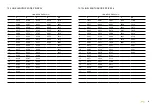
10
3.4 PRE-FLIGHT CHECK
Once ready, but before taking off, conduct another equipment
inspection. Conduct a thorough visual check of your gear with the wing
fully open, the lines untangled and properly laid out on the ground to
ensure that all is in working order. Be certain the weather conditions are
suited to your flying skill level.
3.5 WING INFLATION, CONTROL AND TAKE OFF
Smoothly and progressively inflate the wing. The KODE P inflates easily
and does not require additional input. The wing does not have the
tendency to overfly the pilot. It is a straight forward exercise leaving
enough time for the pilot to decide whether to accelerate and take off or
not.
If the wind permits, we recommend a reverse launch, as this allows a
better visual inspection of the wing during inflation. In “strong” winds, the
KODE P is especially easy to control using this launch technique. Winds
of 25 to 30 km/h are considered strong for paragliding.
Correctly setting up the wing on the ground before take off is vitally
important. To ensure a clean launch, choose an appropriate location
facing the wind. Position the paraglider in a crescent configuration to
facilitate inflation.
3.6 LANDING
The KODE P lands excellently, it converts the wing speed into lift at your
demand, allowing an enormous margin of error. Wrapping the brake lines
around your hand to get greater braking efficiency is not necessary.
3.7 PACKING
The KODE P has a complex leading edge, manufactured using a variety
of different materials and it must be packed carefully. A correct folding
method is very important to extend the useful life of the paraglider.
It should be concertina-packed, with the leading edge reinforcements flat
and the flexible rods stacked one on top of the other. This method will
keep the profile in its original shape without compromising its profile or
performance. Ensure the reinforcements are not bent or folded. The wing
should not be folded too tightly to avoid damage to the cloth and/or lines.
At Niviuk we have designed the NKare Bag, a bag designed to assist you
with rapid packing which helps maintain the integrity of the leading edge
and keeps its internal structures in perfect condition.
The NKare Bag guides you through the folding process, allowing you to
concertina-pack the wing with each rod on top of the other and then fold
the wing as required. This folding system ensures that both the fabric and
the reinforcements of the internal structure are kept in perfect condition.
4. IN FLIGHT
We recommend that you read the certification test report. The report
contains all the necessary information on how the KODE P reacts during
each of the tested manoeuvres.
It is important to point out that the appropriate response to an adverse
incidence can vary from size to size; even within the same size at
maximum or minimum load the behaviour and reactions of the wing may
vary.
Having the knowledge that the testing house provides through the test
report is fundamental to learning how to deal with possible situations.
We recommend learning to fly this wing under the guidance of a qualified
instructor.











































